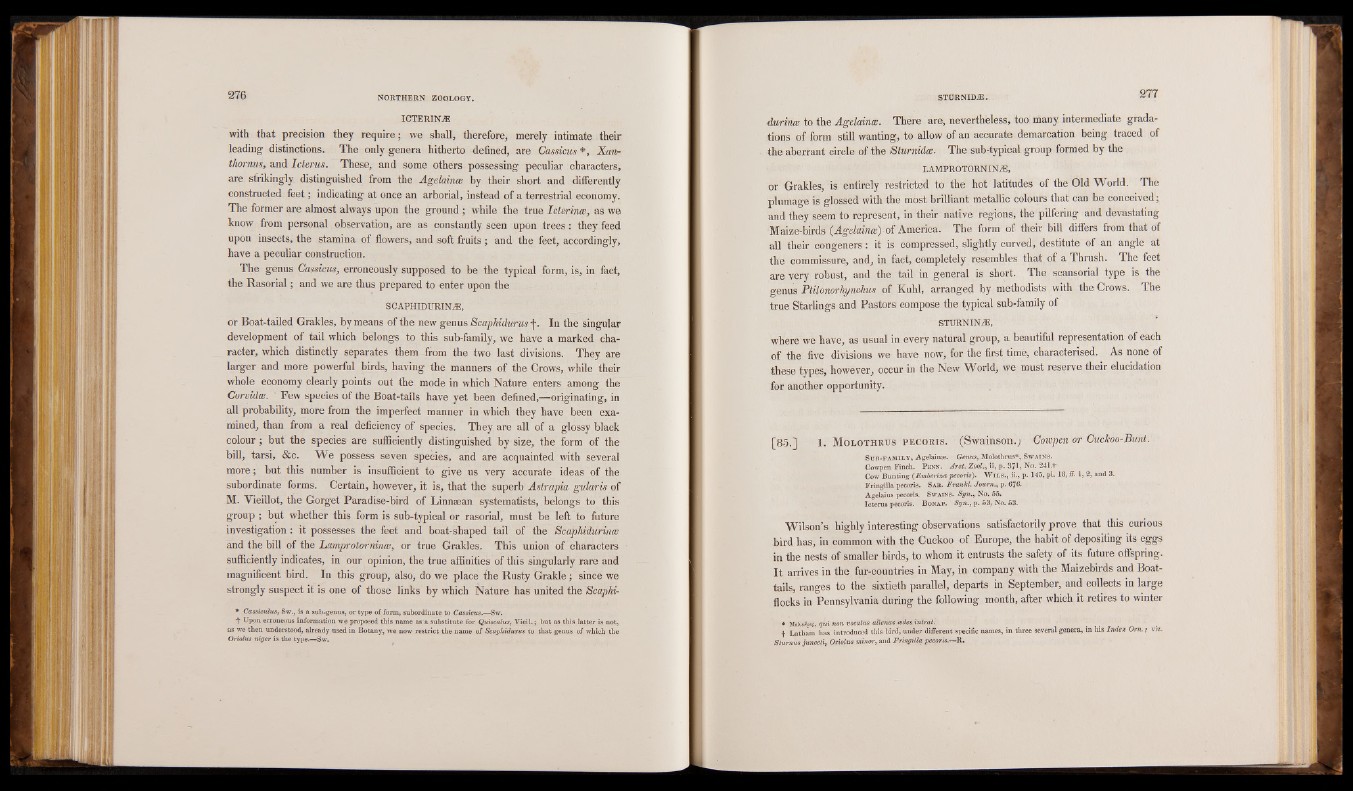
ICTERIN.®
with that precision they require; we shall, therefore, merely intimate their
leading distinctions. The only genera hitherto defined, are Cassicus*, Xan-
thomus, and Icterus. These, and some others possessing peculiar characters,
are strikingly distinguished from the Agelaince by their short and differently
constructed feet; indicating at once an arborial, instead of a terrestrial economy.
The former are almost always upon the ground; while the true Icterirue, as we
know from personal observation, are as constantly seen upon trees : they feed
upon insects, the stamina of flowers, and soft fruits; and the feet, accordingly, have a peculiar construction.
The genus Cassicus, erroneously supposed to be the typical form, is, in fact,
the Rasorial; and we are thus prepared to enter upon the
SCAPHIDURIN^E,
or Boat-tailed Gfakles, by means of the new genus Scaphidurus-f. In the singular
development of tail which belongs to this sub-family, we have a marked character,
which distinctly separates them from the two last divisions. They are
larger and more powerful birds, having the manners of the Crows, while their
whole economy clearly points out the mode in which Nature enters among the
Corrida;. Few species of the Boat-tails have yet been defined,—originating, in
all probability, more from the imperfect manner in which they have been examined,
than from a real deficiency of species. They are all of a glossy black
colour ; but the species are sufficiently distinguished by size, the form of the
bill, tarsi, &c. We possess seven species, and are acquainted with several
more; but this number is insufficient to give us very accurate ideas of the
subordinate forms. Certain, however, it is, that the superb Astrapia gularis of
M. Vieillot, the Gorget Paradise-bird of Linnsean systematists, belongs to this
group ; but whether this form is sub-typical or rasorial, must be left to future
investigation: it possesses the feet and boat-shaped tail of the Scaphidurince and the bill of the Lamprotorninw, or true Grakles. This union of characters
sufficiently indicates, in our opinion, the true affinities of this singularly rare and
magnificent bird. In this group, also, do we place the Rusty Grakle; since we
strongly suspect it is one of those links by which Nature has united the Scaphi-
* Cassiculus, Sw., is a sub-genus, or type of form, subordinate to Cassicus.—Sw.
+ Upon erroneous information we proposed this name as a substitute for Quiscalus, Vieil.; but as this latter is not,
as we then understood, already used in Botany, we now restrict the name of Scaphidwrus to that genus of which the
Oriolus niger is the type.—Sw.
durince to the Agelainie. There are, nevertheless, too many intermediate gradations
of form still wanting, to allow of an accurate demarcation being traced of
the aberrant circle of the Sturnidte. The sub-typical group formed by the
LAMPROTORNIN^E,
or Grakles, is entirely restricted to the hot latitudes of the Old World. The
plumage is glossed with the most brilliant metallic colours that can be conceived;
and they seem to represent, in their native regions, the pilfering and devastating
Maize-birds (Agelaince) of America. The form of their bill differs from that of
all their congeners: it is com pressed, slightly curved, destitute of an angle at
the commissure, and, in fact, completely resembles that of a Thrush. The feet
are very robust, and the tail in general is short. The seansorial type is the
genus Ptilonorhynehus of Kuhl, arranged by methodists with the Crows. The
true Starlings and Pastors compose the typical sub-family of
STTJRNIN.55,
where we have, as usual in every natural group, a beautiful representation of each
of the five divisions we have now, for the first time, characterised. As none of
these types, however, occur in the New World, we must reserve their elucidation
for another opportunity.
[85.] 1. Molothrus pecoris. (Swainson.; Cowpen or Cuckoo-Bunt.
Su b -f a m il y , Agelainæ. Genus, Molothrus*, Sw a in s.
Cowpen Finch. P enn. Arct. Zool., ii, p. 371, No. 241.+
Cow Bunting (Emberiza pecoris). Wins., ii., p. 145, pi. 18, ff. 1, 2, and 3.
Fringilla pecoris. Sab. Frankl. Jowm., p. 676.
Agelaius pecoris. Swains. Syn., No. 55.
Icterus pecoris. B onap. Syn., p. 53, No. 53.
Wilson’s highly interesting observations satisfactorily prove that this curious
bird has, in common with the Cuckoo of Europe, the habit of depositing its eggs
in the nests of smaller birds, to whom it entrusts the safety of its future offspring.
It arrives in the fur-countries in May, in company with the Maizebirds and Boat-
tails, ranges to the sixtieth parallel, departs in September, and collects in large
flocks in Pennsylvania during the following month, after which it retires to winter
* MoAo^+ Lathamoj, hqausi ninotnr ovdouccaetuds tahliisé nbairsd oe, duensd ienrt rdaitf.ferent specific names, in three several genera, in his Index Om. ; viz.
Stumus junceti, Oriolus minor, and Fringilla pecoris. R.